Death is not the greatest loss in life. The greatest loss is what dies inside us while we live.
- Norman Cousins
We've created something that will affect your children's children. Can YOU say the same about YOUR life?
- "BP Public Relations" (BPGlobalPR) (NOTE: SPOOF ACCOUNT)
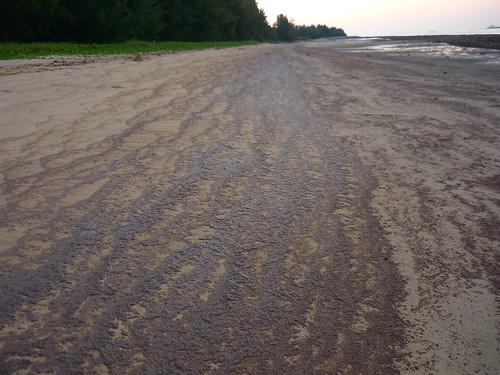
Saturday morning, and I went down to a special stretch of seashore at Tanah Merah to see how the oil spill has affected the marine life. Ria and Chay Hoon had documented the impacts on one end of the shore, so I decided to explore the other end. This is one of the areas where the oil first hit the coast, so it is particularly important to see how the various marine animals are coping with the large amounts of crude oil that have suddenly washed up here.
Before I even set foot on the sand, I could notice 2 things. The first was the overwhelming smell of petroleum. The second was the long stretch of black deposits on the sand, which I correctly guessed was the result of oil being washed up onto the beach.
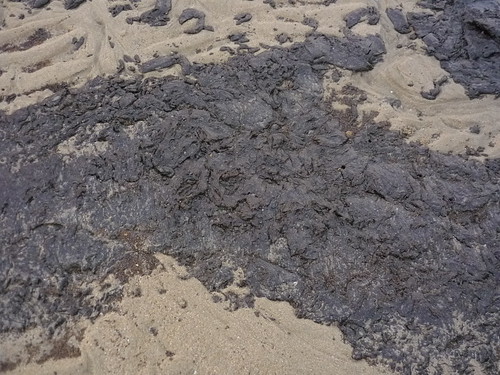
The sand on the high shore is coated with a layer of oil.
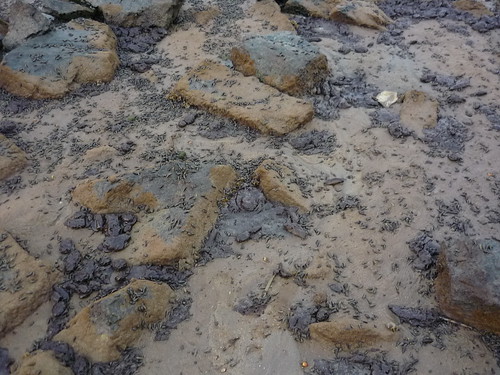

Further down, closer to the seawall, I can see that the swarms of zoned horn snails (Batillaria zonalis) are still present. They all seem to have hunkered down and are not moving at all.
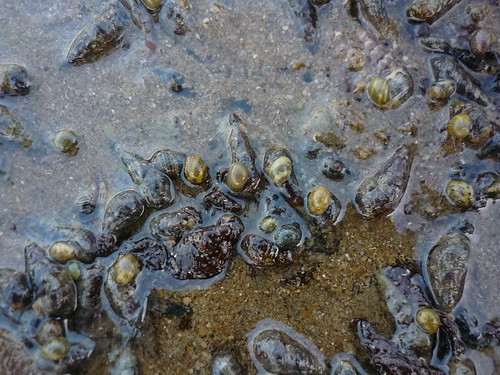
The tiny dubious nerites (Clithon oualaniensis ) are still abundant, but like the zoned horn snails, they're not doing much for now except sit around.
The larger nerites (Nerita spp.) that are normally so common on the rocks seem to have completely vanished.
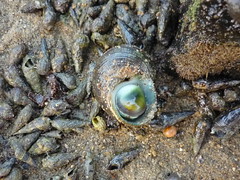
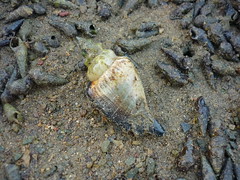
Other snails, such as this dwarf turban snail (Turbo bruneus) and black-lipped conch (Canarium urceus), also appear to be trying to wait out the worst of the spill.
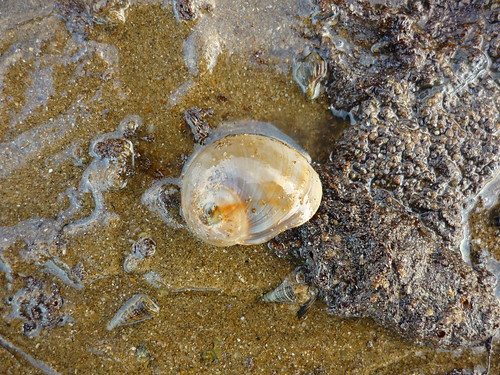
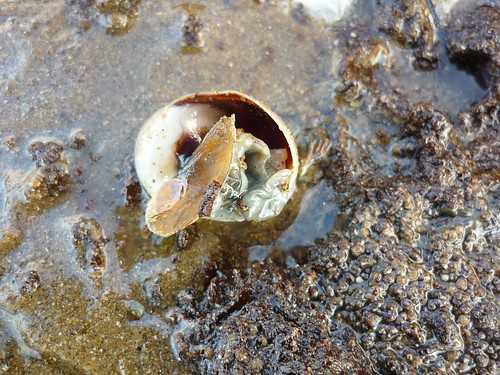
This ball moon snail (Polinices didyma) however was quite dead.
Unlike the snails, the worms (to use the term in general) are in really bad shape.
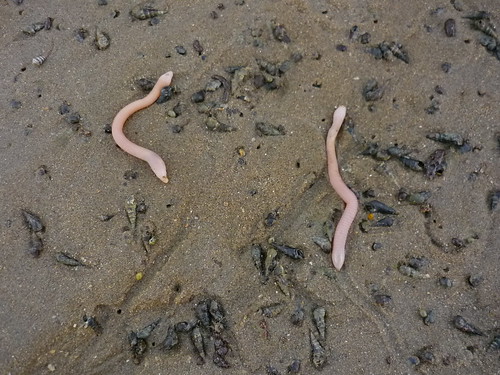
I don't normally encounter peanut worms (Sipuncula) alive on the shore, and definitely not in broad daylight. Normally, these worms live buried in the substrate. However, today, the shore is full of peanut worms.

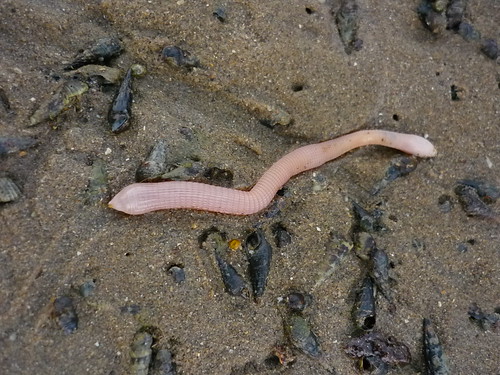




Some of them have turned a pale white, and are still weakly crawling about helplessly. Others are clearly very dead.

You may make fun of me for feeling pity for a worm, but it was quite heartbreaking to see such a huge worm barely clinging on to life, making half-hearted attempts to crawl around in a futile effort to escape the pollution that had suddenly swamped its home.

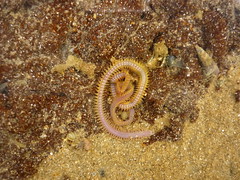
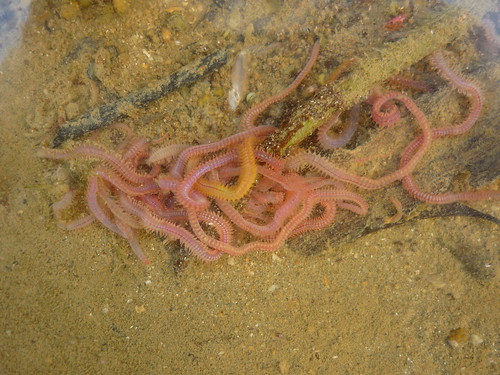
I suppose that these polychaete worms (Polychaeta) are usually buried in the sand and mud. Today, I saw large groups of them wriggling around, twisting and writhing aimlessly, as if in a last-ditch, uncoordinated effort to swim away and flee from danger.

Acorn worms (Enteropneusta) and their casts are scattered here and there, but I have no way of knowing how they're coping. I guess it's a good sign that they're not emerging from the sand and dying en masse like the peanut worms.
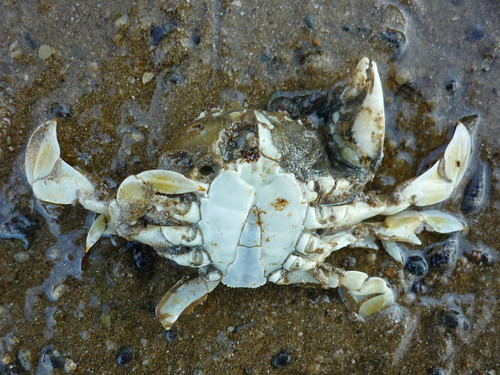
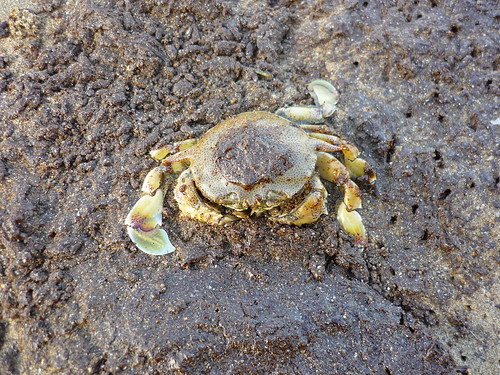

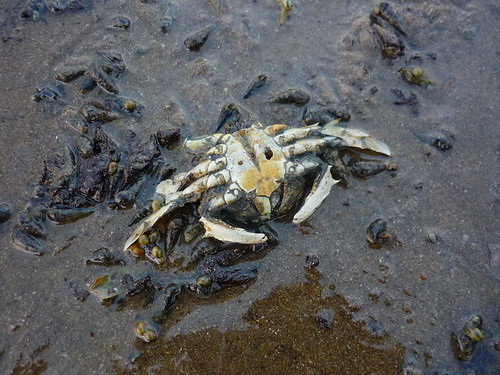
The crabs also seem to coping very poorly. Dead spotted moon crabs (Ashtoret lunaris) were scattered everywhere. I gave up counting after 15.

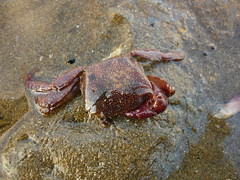
I saw a couple of dead purple climber crabs (Metopograpsus sp.).

A dead soldier crab (Dotilla sp.). I saw 2 live soldier crabs, but they seemed a little disoriented.

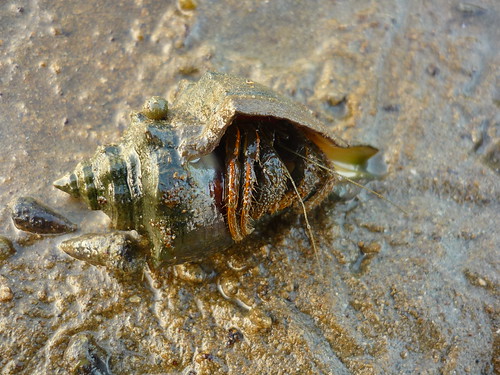
I saw a few live flower crabs (Portunus pelagicus) and orange striped hermit crabs (Clibanarius infraspinatus). They seem much more lethargic than usual.

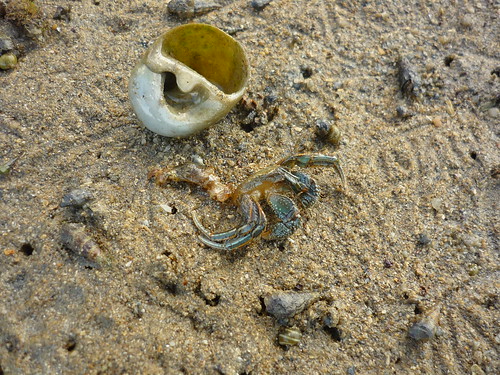
I didn't check if this flower crab and orange striped hermit crab were actual carcasses or discarded moults.
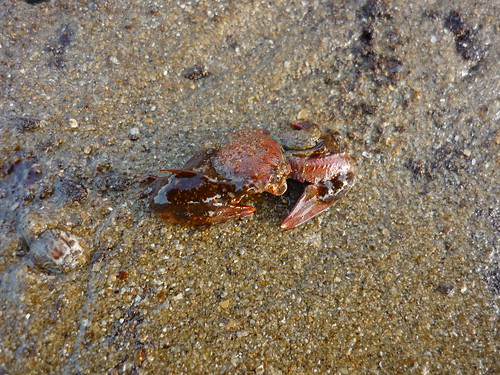
Dead big red porcelain crab (Petrolisthes sp.).
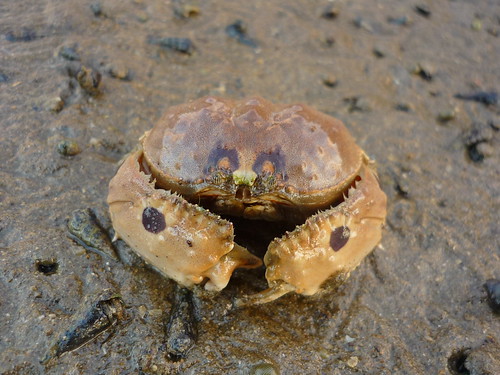
The most exciting find was this crab.
It's a spotted box crab (Calappa philargius). All past sightings of this crab have been at Changi, so it is a first for Tanah Merah. It's also my first time seeing this species. Not to mention that the others have not seen this crab in years; apparently, the last recorded sighting was in May 2006. I seem to be having quite a bit of luck in finding box crabs lately; in April, I found a reef box crab (Calappa hepatica) at Pulau Hantu, which was the first time any one of us had spotted this species on our intertidal trips.
Fortunately, the spotted box crab was still very much alive. I hope it survives the oil spill, and that we'll be able to find more box crabs in future visits.
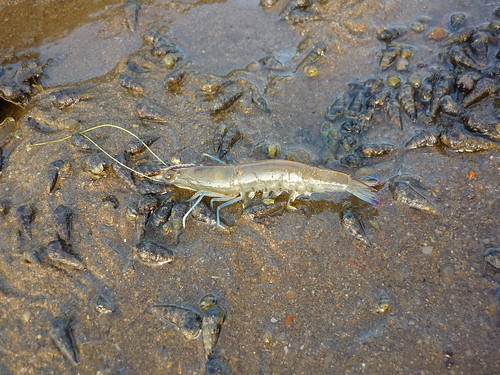
This blue-tailed prawn (Penaeus latisulcatus) was still alive, even though it was out of the water. I flicked it into the nearest pool, and it seemed a little dazed.
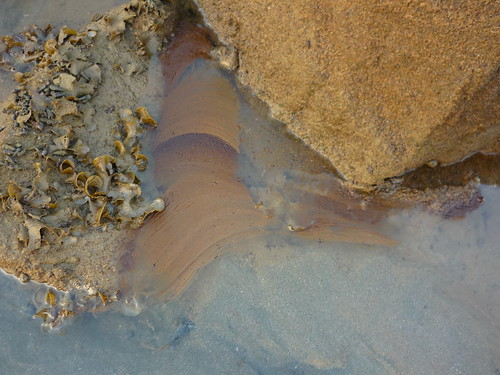

There is a thin oily film on the surface of many of the larger pools. As the tide comes in, this sheen soon covers the entire lagoon.
The fish seem to be doing alright. I saw many schools of tiny fish swimming around in the pools, even those that had a thin film of oil on the surface. Gobies like the shadow goby (Acentrogobius nebulosus) seemed quite unaffected by the oil.
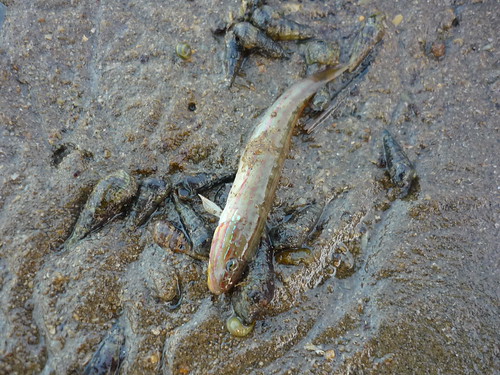
Like the blue-tailed prawn, this head-stripe goby (Amblygobius stethophthalmus) was found out of the water, but it swam off once it was flicked into a pool.
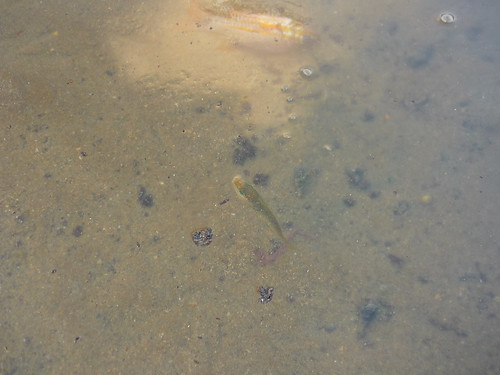
This fish however, was gasping for air at the surface, which is not a good sign at all.
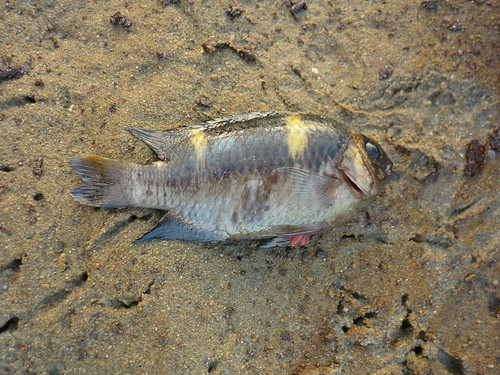

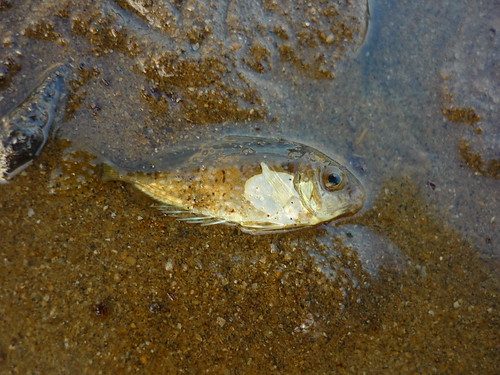
There were some casualties among the fishes, like this yellow-banded damselfish (Dischistodus fasciatus), lined cardinalfish (Cheilodipterus sp.), and juvenile rabbitfish (Siganus sp.).
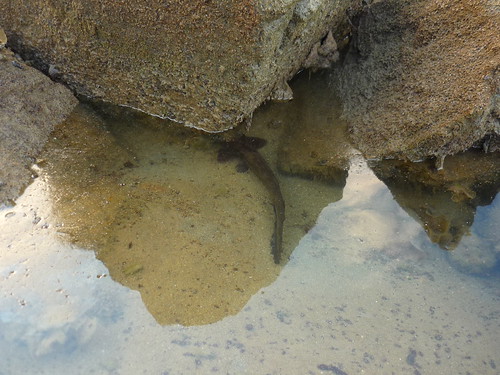
This large eel-tailed catfish (Plotosus sp.) was hanging out beneath a rock during the daytime, which is quite unusual behaviour for a catfish. I wanted to go closer to take a photo, but it wriggled deeper among the rocks.
That was when I saw something else nearby that sent a chill down my spine.

Ah yes, it's been a while since my last brush with an estuarine stonefish (Synanceia horrida). We are always extremely wary on this shore, having had a few close shaves with stonefish on many occasions.

The stonefish does not seem to be too badly affected by the oil spill. But then again, stonefish are usually so lethargic and loathe to move around that you can't tell if it's more sluggish than usual.
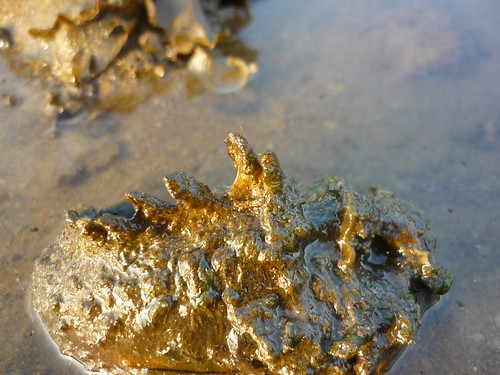
The spines on the dorsal fin are raised when the stonefish feels threatened. These spines act as hypodermic needles, injecting venom when contact is made with the threat. For an unfortunate shore explorer, this is usually on the sole of the foot.

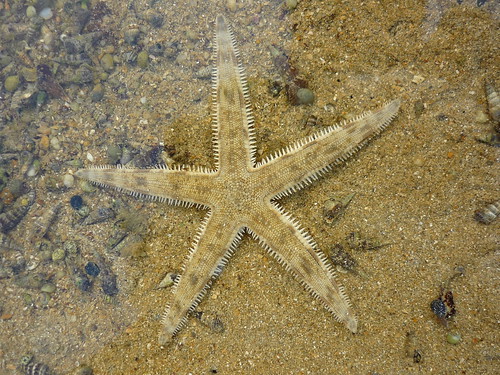
The only echinoderms I saw were a few common sea stars (Archaster typicus). They appeared to be doing fine.

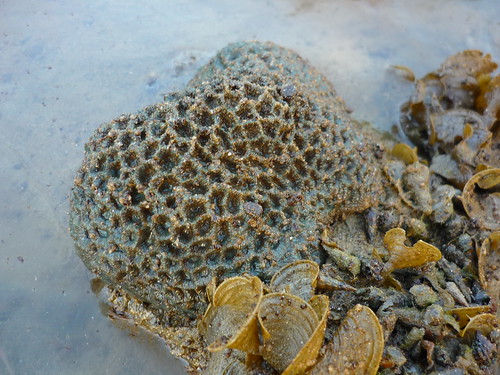
There are some hard corals scattered here and there among the rocks. Some of them show signs of having been covered in oil. I hope they survive this ordeal. In fact, I'm now wondering how the reef on the seaward side of the seawall has fared.
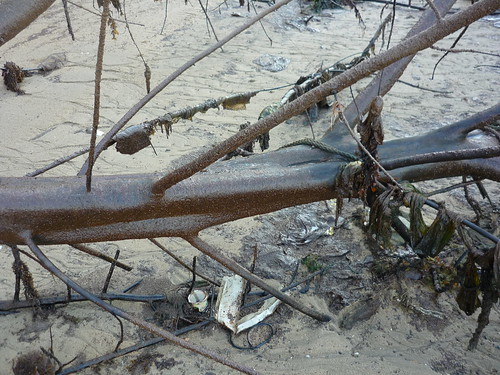
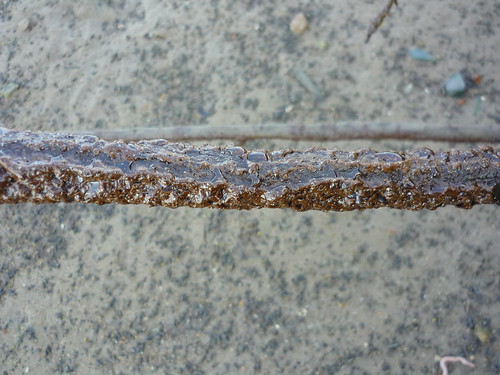
This fallen rhu tree (Casuarina equisetifolia) is covered in a glistening coat of oil.

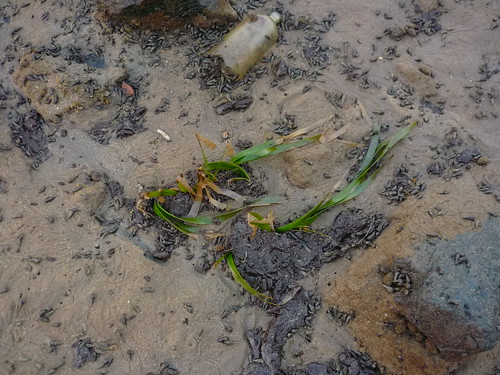
The seagrasses still seem fairly alright; the patches of smooth ribbon seagrass (Cymodocea rotundata) and clumps of tape seagrass (Enhalus acoroides) are still alive, albeit somewhat stained with oil. At least they haven't been smothered and buried.

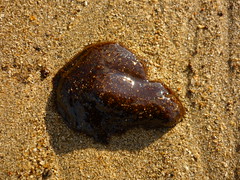
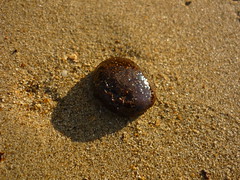
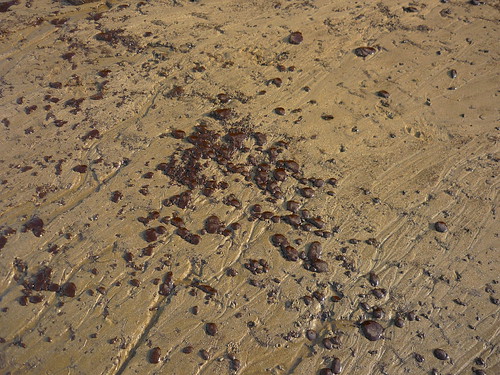
There were globules of oil scattered around on the sand.
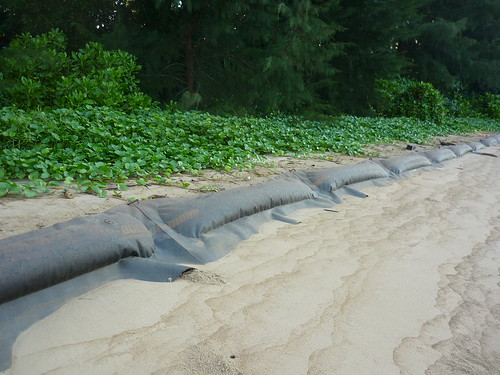
A large boom has been installed on the high shore, probably to prevent the oil from being deposited further inland.
It's difficult not to feel a sense of helplessness and outrage at what has happened here. This is a shore that stands as a living example of the resilience of our marine life, able to recover and in fact recolonise areas that have been reclaimed and altered by human activities. It is a shore that never fails to amaze and surprise us with the dazzling variety of animals that have been found living on such an unassuming shore, and every visit yields new discoveries. And yet, disaster has struck, and a little part of me died inside, seeing how the habitats have been so profoundly affected by the oil spill.
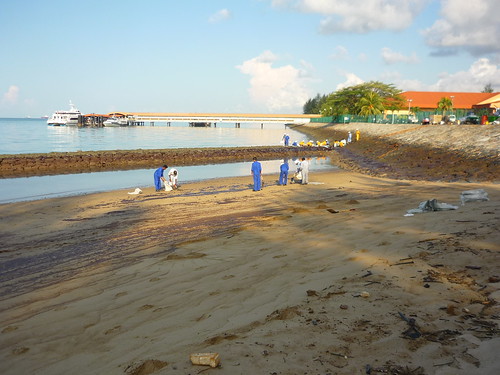
As I was leaving, I spotted several groups of people on the shore.
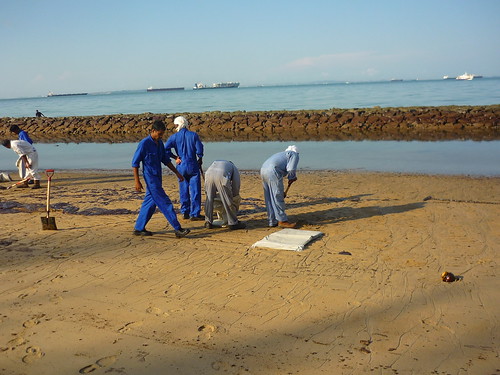

It turned out that these were workers here to clean up the oil. A group was shoveling the layer of sand that was stained with oil into bags, while another group was mopping up the oil on the rocks.
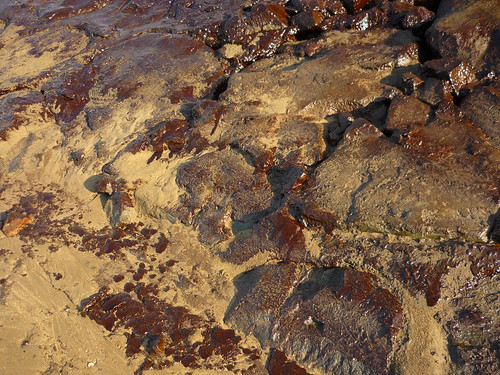
I spoke to one of the men who was overseeing the cleanup operations. Apparently, he is a marine biologist from the International Tanker Owners Pollution Federation (ITOPF), a group that 'provides objective technical advice and information on all aspects of pollution response and the effects of spills on the marine environment. Our technical services include on-site clean-up advice, pollution damage assessment, assistance in spill response planning, and the provision of training and information.' He said that he was based in London, and was here in Singapore specifically to provide guidance and advice on combating the oil spill. He commented that in comparison with oil spills that he had seen elsewhere, this is considered to be quite mild in terms of the impacts on marine life.

In a way, he has a point. Singapore's waters are polluted to some degree, and there is always some amount of oil floating around in the water, especially in areas with high marine traffic. It is not unexpected that the organisms in some areas have adapted to tolerate some amount of oil in the environment. Whether or not they are able to survive this oil spill is another matter altogether; while some groups of animals seem to be decimated, others seem capable of weathering the worst of it.

Still, it is depressing to see the heavy toll on the marine life that inhabit this shore. Even those creatures that survive might suffer from long-term effects caused by prolonged exposure to toxic substances in the oil. Or the ecosystem might be greatly altered due to the massive die-off of certain species, with shifts and upheavals in trophic relationships.

Tanah Merah will recover eventually. Given enough time, the animals will repopulate the area, and I am fairly confident that we will one day see the shores of Tanah Merah restored to their former beauty. Life always finds a way. But for now, all we can do is hope that the cleanup efforts succeed in minimising the damage, not just here, but on other shores like Changi and Chek Jawa, which have also been hit by the oil spill.
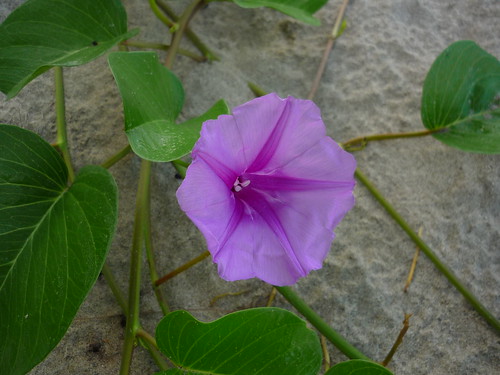
Hope springs eternal.